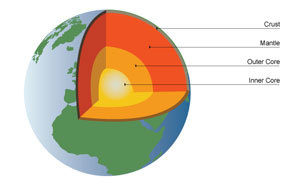9th Grade > Biology
NATURAL RESOURCES MCQs
Total Questions : 47
| Page 1 of 5 pages
Answer: Option A. -> True
:
A
Humus is a major factor in deciding the soil structure because it causes the soil to become more porous and allows water and air to penetrate deep underground.
:
A
Humus is a major factor in deciding the soil structure because it causes the soil to become more porous and allows water and air to penetrate deep underground.
Answer: Option B. -> denitrification
:
B
The nitrates which are formed by the process of nitrification are utilized by the plants. The excess nitrates in the soil are released back in the atmosphere as atmospheric nitrogen by denitrifying bacterias. This process is known as denitrification.
:
B
The nitrates which are formed by the process of nitrification are utilized by the plants. The excess nitrates in the soil are released back in the atmosphere as atmospheric nitrogen by denitrifying bacterias. This process is known as denitrification.
Answer: Option A. -> True
:
A
The fossil fuels like coal and petroleum produces oxides of nitrogen and sulphur when they are burnt. These oxides are mixed up with rain water which give rise to acid rain.
:
A
The fossil fuels like coal and petroleum produces oxides of nitrogen and sulphur when they are burnt. These oxides are mixed up with rain water which give rise to acid rain.
Answer: Option A. -> True
:
A
Soil formation is influenced by physical, chemical and biological processes. Physical factors like water and wind, chemical processes like hydration, biological factors like living organisms do influence soil formation.
:
A
Soil formation is influenced by physical, chemical and biological processes. Physical factors like water and wind, chemical processes like hydration, biological factors like living organisms do influence soil formation.
Answer: Option A. -> True
:
A
Ozone layer is present in the lower parts of thestratosphere. It absorbs all the ultraviolet radiations and does not allow them to reach Earth's surface, thus protecting all living organisms from the harmful effects of UV radiations.
:
A
Ozone layer is present in the lower parts of thestratosphere. It absorbs all the ultraviolet radiations and does not allow them to reach Earth's surface, thus protecting all living organisms from the harmful effects of UV radiations.
Answer: Option D. -> Nitrates
:
D
Plants cannot use the atmospheric nitrogen directly.Nitrogen fixation is abiological process and theinitial stage ofnitrogen cycle which converts atmospheric nitrogeninto ammonia. This ammonia is converted into nitrite and then into nitrate by theprocess of nitrification. Nitrateis the form of nitrogen which isdirectly absorbed and used by the plants for making amino acids andproteins.
:
D
Plants cannot use the atmospheric nitrogen directly.Nitrogen fixation is abiological process and theinitial stage ofnitrogen cycle which converts atmospheric nitrogeninto ammonia. This ammonia is converted into nitrite and then into nitrate by theprocess of nitrification. Nitrateis the form of nitrogen which isdirectly absorbed and used by the plants for making amino acids andproteins.
Answer: Option C. -> 78% and 21% approx
:
C
Air is a mixture of many gases. It is primarily composed ofapprox78%nitrogen and 21%oxygenwith only small concentrationof other gases such as carbon dioxide and argon.
:
C
Air is a mixture of many gases. It is primarily composed ofapprox78%nitrogen and 21%oxygenwith only small concentrationof other gases such as carbon dioxide and argon.
Answer: Option A. -> soil pollution
:
A
The addition or removal of constituents from soil, changing its natural composition is called soil pollution. There is a substantial decrease in soil fertility due to soil pollution. This is because ofthe addition of contaminants that alters the chemistry of the soil.
:
A
The addition or removal of constituents from soil, changing its natural composition is called soil pollution. There is a substantial decrease in soil fertility due to soil pollution. This is because ofthe addition of contaminants that alters the chemistry of the soil.
Answer: Option C. -> glaciers
:
C
Out of the 3% of the fresh water found on the Earth's surface, majority is found in the form of glaciers. Almost 90% of the fresh water of Earth's ice mass is in Antarctica. The rivers and underground water are fresh water bodies while ocean water is saline.
:
C
Out of the 3% of the fresh water found on the Earth's surface, majority is found in the form of glaciers. Almost 90% of the fresh water of Earth's ice mass is in Antarctica. The rivers and underground water are fresh water bodies while ocean water is saline.

















